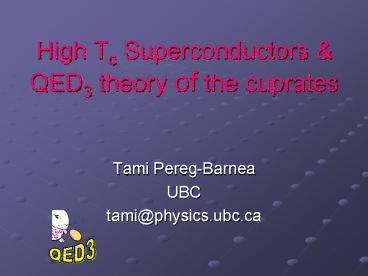High Tc Superconductors - PowerPoint PPT Presentation
1 / 20
Title:
High Tc Superconductors
Description:
Attempts to solve the problem. The inverted approach. QED3 ... Formalism. Start with the BdG Hamiltonian. FT transformation in order to avoid branch cuts. ... – PowerPoint PPT presentation
Number of Views:169
Avg rating:3.0/5.0
Title: High Tc Superconductors
1
High Tc Superconductors QED3 theory of the
cuprates
- Tami Pereg-Barnea
- UBC
- tami_at_physics.ubc.ca
QED3
2
outline
- High Tc Known and unknown
- Some experimental facts and phenomenology
- Models
- Attempts to solve the problem
- The inverted approach
- QED3 formulations and consequences
3
Facts
- The parent compounds are AF insulators.
- 2D layers of CuO2
- Superconductivity is the condensation of Cupper
pairs with a D-wave pairing potential. - The cuprates are superconductors of type II
- The normal state is a non-Fermi liquid,
strange metal.
4
YBCO microwave conductivity
BSCCOARPES
5
Neutron scattering (p,p) resonance in YBCO
Underdoped Bi2212
6
Phenomenology
- The superconducting state is a D-wave BCS
superconductors with a Fermi liquid of nodal
quasiparticles. - The AF state is well described by a Mott-Hubbard
model with large U repulsion. - The pseudogap is strange!
- Gap in the excitation of D-wave symmetry but no
superconductivity - Non Fermi liquid behaviour anomalous power laws
in verious observables.
7
Phase diagram
AF
AF
AF
8
Theoretical approaches
- Starting from the Hubbard model at ½ filling.
- Slave bosons SU(2) gauge theories
- Spin and charge separation
- Stripes
- Phenomenological
- SO(5) theory
- DDW competing order
9
The inverted approach
- Use the phenomenology of d-SC as a starting
point. - Destroy superconductivity without closing the
gap and march backwards along the doping axis. - The superconductivity is lost due to
quantum/thermal fluctuations in the phase of the
order parameter.
10
Vortex Antivortex unbinding
Emery Kivelson Nature 374, 434 (1995) Franz
Millis PRB 58, 14572 (1998)
11
Phase fluctuations
- Assume D0 D const.
- Treat expif(r) as a quantum number sum over
all paths. - Fluctuations in f are smooth (spin waves) or
singular (vortices). - Perform the Franz Teanovic transformation - a
singular gauge transformation. - The phase information is encoded in the dressed
fermions and two new gauge fields.
12
Formalism
- Start with the BdG Hamiltonian
- FT transformation in order to avoid branch cuts.
13
The transformed Hamiltonian
- The gauge field am couples minimally ?m ? am
- The resulting partition function is averaged over
all A, B configurations and the two gauge fields
are coarse grained.
14
The physical picture
- RG arguments show that vm is massive and
therefore its interaction with the Toplogical
fermions is irrelevant. - The am field is massive in the dSC phase
(irrelevant at low E) and massless at the
pseudogap. - The kinetic energy of am is Maxwell - like.
15
Quantum Electro Dynamics
- Linearization of the theory around the nodes.
- Construction of 2 4-component Dirac spinors.
16
Dressed QPs
Optimally doped BSCCO Above Tc T.Valla et al.
PRL (00)
QED3 Spectral function
17
Chiral Symmetry Breaking ? AF order
- The theory of Quantum electro dynamics has an
additional symmetry, that does not exist in the
original theory. - The Lagrangian is invariant under the global
transformation where G is a linear
combination of
18
- The symmetry is broken spontaneously through the
interaction of the fermions and the gauge field. - The symmetry breaking (mass) terms that are added
to the action, written in the original nodal QP
operators represent - Subdominant dis SC order parameter
- Subdominant dip SC order parameter
- Charge density waves
- Spin density waves
19
Antiferromagnetism
- The spin density wave is described by
- where ?, ? labels denote nodes.
- The momentum transfer is Q, which spans two
antipodal nodes. - At ½ filling, Q ? (?,?) commensurate
Antiferromagnetism.
_
20
Summary
- Inverted approach dSC ? PSG ? AF
- View the pseudogap as a phase disordered
superconductor. - Use a singular gauge transformation to encode the
phase fluctuation in a gauge field and get QED3
effective theory. - Chirally symmetric QED3 ? Pseudogap
- Broken symmetry ? Antiferromagnetism































